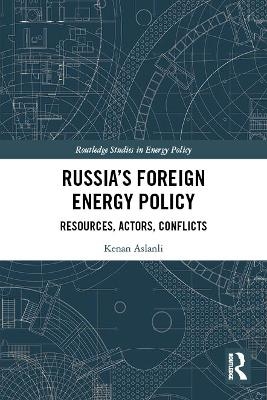
Russia’s Foreign Energy Policy
Routledge (Verlag)
978-1-032-52809-0 (ISBN)
- Noch nicht erschienen (ca. Dezember 2024)
- Versandkostenfrei innerhalb Deutschlands
- Auch auf Rechnung
- Verfügbarkeit in der Filiale vor Ort prüfen
- Artikel merken
This book examines Russia’s multidimensional foreign energy policy and the emerging and ongoing conflicts with energy-consuming and transit countries.
Russia’s Foreign Energy Policy examines whether the interdependence patterns shaped through various channels (such as foreign trade, investment, finance, technology, and social interactions) between Russia and energy-importing countries could prevent energy-based conflict. Drawing on semi-structured expert interviews, Kenan Aslanli challenges the one-sided conventional wisdom that focusses on foreign policy ambitions and overlooks the peculiarities of the energy dimension. Instead, Aslanli highlights the complexity of contemporary energy affairs using a holistic approach that goes beyond geopolitics. He examines various energy types such as crude oil, natural gas, and nuclear and considers a diverse range of actors which include energy companies and international organizations. Using examples from Europe, Asia, and the Middle East, Aslanli demonstrates how the Russian strategy of using energy resources as a tool or energy weapon for foreign policy goals has a diminishing return in the long run.
This book will be of great interest to students and scholars of energy policy, foreign policy, and Russian studies more broadly.
Kenan Aslanli is a faculty member at Ankara Yıldırım Beyazıt University (AYBU), Department of International Relations. He works as an expert on the energy and political economy of the wider Eurasian powers at the Center for Iranian Studies (IRAM) in Turkey. He graduated from the doctorate programme at Ankara Yıldırım Beyazıt University, Department of International Relations (English), in 2022. He was a project partner and researcher at the Center for Eastern European Studies at the University of Bremen (Forschungsstelle Osteuropa) and a visiting lecturer at the Vienna BFI University of Applied Sciences (Austria).
Contents
LIST OF ABBREVIATIONS
LIST OF FIGURES AND TABLES
CHAPTER 1. INTRODUCTION
1.1. Research Rationale, Problematization, and Theoretical Framework
1.2. Research Design and Methodology
1.3. Research Methods
1.3.1. Semi-Structured Expert Interviews
1.3.2. The Methodology of RECSID and Statistical Data Analysis
1.3.3. Basic Content Analysis
1.4. Research's Limitations and Challanges
1.5. Contribution to the Existing Literature and Future Studies
1.6. Short Outline of the Following Chapters of the Book
CHAPTER 2. THEORETICAL FRAMEWORK
2.1. Overview of Basic Literature on Russia’s Foreign Energy Policy
2.2. The Relevance and Operationalization of Complex Interdependence Theory
2.3. Review of the Alternative Theories on Russia’s FEP
2.4. "Energy Weapon" and "Energy Superpower" Concepts
CHAPTER 3. CONCEPTUAL FRAMEWORK: FOREIGN POLICY, FOREIGN ENERGY POLICY, AND ENERGY CONFLICTS
3.1. Russia’s Foreign Energy Policy and Grand Strategy
3.2. Russia’s Militarist Strategic Culture and Foreign Energy Policy
3.3. Periods of Foreign Policy, Energy Dimension, and Domestic Conditions
3.4. USSR’s FEP: Lesson Learnt for Russia
3.5. Overview and Objectives of Russia’s FEP Pattern
3.6. Russia’s Energy Conflicts and Tools of FEP
CHAPTER 4. EMPIRICAL CONTENT: ECONOMIC PERFORMANCE AND ENERGY RESOURCES
4.1. The Role of Energy in the Russian Economy and Economic Performance
4.1.1. Russia’s economic growth and the share of oil-gas in GDP
4.1.2. Oil-gas reliance of the export and fiscal system
4.1.3. Forex reserves, debt, and FDI
4.1.4. Social development indicators and regional disparities
4.1.5. Russia's foreign trade and energy factor
4.1.6. Russia’s foreign trade and technological backwardness
4.2. Russia’s Energy Reserves and FEP
4.2.1. Russia's oil reserves
4.2.2. Russia’s oil production
4.2.3. Russia’s crude oil and petroleum products export
4.2.4. Russia’s gas reserves and gas production
4.2.5. Russia’s gas export
4.2.6. Coal reserves, production, and exports
4.2.7. The energy balance and renewables in Russia
CHAPTER 5. MAJOR ACTORS OF FEP: ENERGY COMPANIES, GOVERNMENT, AND STRATEGIC DOCUMENTS
5.1. Russian Energy Companies: Profiles and Global Networks
5.1.1. Gazprom
5.1.2. Rosneft
5.1.3. Lukoil
5.1.4. Transneft
5.1.5. Inter RAO UES
5.1.6. Rosatom
5.2. Concentration and Monopolization by the Russian Energy Companies
5.3. Foreign Energy Companies Operating in Russia
5.4. The Role of Government in the Russian FEP
5.5. Russia’s Strategic Documents on Foreign and Energy Policy
CHAPTER 6. RUSSIA’S ENERGY CONFLICTS AND SUPPLY INTERRUPTIONS DATASET (RECSID)
6.1. Analysis of RECSID’s Main Findings on Energy Conflicts in Russia
6.2. Russia’s Energy Conflicts and Energy Types Based on RECSID
6.3. The Energy Conflicts, Oil Prices, and Domestic Politics Based on RECSID
6.4. Energy Conflicts and Economic Interdependence Based on RECSID
CHAPTER 7. MOTIVATIONS, DETERMINANTS, AND CONSTRAINTS OF RUSSIA’S FEP AND ENERGY CONFLICTS
7.1. Russia’s Energy Conflicts with Major Energy Partners
7.2. Motivations of Russia’s Energy Conflicts
7.3. Rebalancing of the Interdependence: Energy Diversification and Sanctions
7.4. Assumptions of Expert Interviews on Russia’s FEP and Energy Conflicts
7.5. Basic Content Analysis of the Official Texts on the Russian FEP
7.6. Determinants and Constraints of Russia’s Foreign Energy Policy
CHAPTER 8. CONCLUSION AND POLICY IMPLICATIONS
APPENDICES
Appendix 1. Correlation Ratios of Energy Conflicts and Various Indicators
Appendix 2. Indicators of the Energy Strategy of Russia for 2035
Appendix 3. 10 Major Indicators for National (Economic & Military) Power (2019)
Appendix 4. Examples from RECSID (Energy Conflict Tracker for Russia)
Index
| Erscheinungsdatum | 06.09.2023 |
|---|---|
| Reihe/Serie | Routledge Studies in Energy Policy |
| Zusatzinfo | 40 Tables, black and white; 37 Line drawings, black and white; 1 Halftones, black and white; 38 Illustrations, black and white |
| Verlagsort | London |
| Sprache | englisch |
| Maße | 156 x 234 mm |
| Themenwelt | Naturwissenschaften ► Biologie ► Ökologie / Naturschutz |
| Naturwissenschaften ► Physik / Astronomie | |
| Sozialwissenschaften ► Soziologie ► Spezielle Soziologien | |
| Technik ► Bauwesen | |
| ISBN-10 | 1-032-52809-5 / 1032528095 |
| ISBN-13 | 978-1-032-52809-0 / 9781032528090 |
| Zustand | Neuware |
| Haben Sie eine Frage zum Produkt? |
aus dem Bereich


